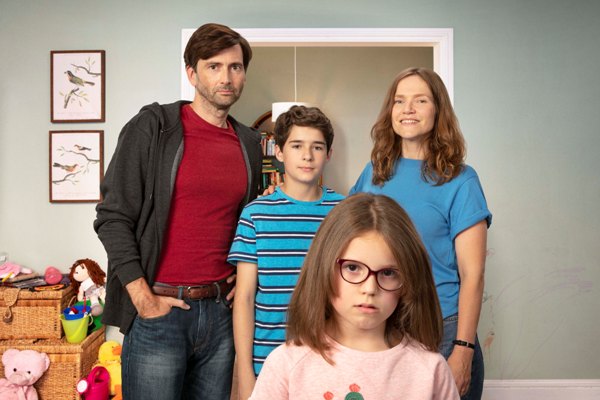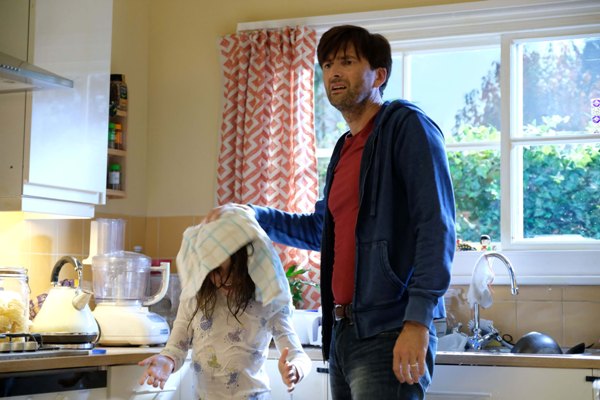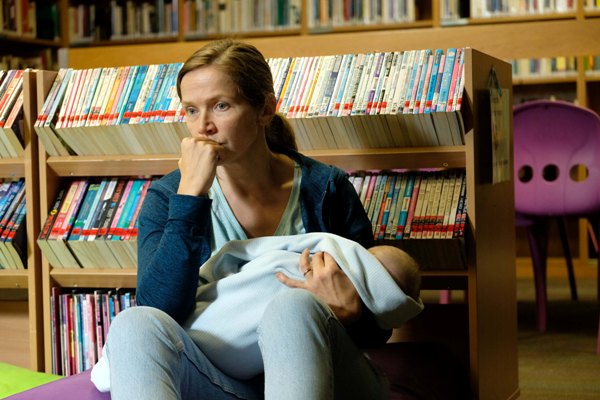The creator, producer, and commissioning executive of There She Goes, one of my early picks for best British TV premieres of 2019, chatted with me about this excellent new series.

There She Goes is a rarity on television.
Other comedy-drama series may be based on actual events and people, but by and large they take a bit of creative license here and there to add oomph to the narrative. This isn’t a bad thing, to be sure, but it is the one thing that prevents a series from being completely authentic.
Not so There She Goes, the new series created and written by Shaun Pye (A Young Doctor’s Notebook & Other Stories, The Increasingly Poor Decisions of Todd Margaret), produced and co-executive produced by Clelia Mountford (Motherland, Mr. Sloane), and commissioned by Shane Allen, the BBC’s Controller of Comedy Commissioning.
Based on the real-life experiences of Shaun and his family, the series follows the lives of Simon and Emily and their children, Ben and Rosie — the “she” of There She Goes — a young girl who, like Shaun’s daughter Joey, was born with a chromosomal disorder and is learning-disabled. Playing Shaun and his on-screen wife, son, and daughter are David Tennant (Doctor Who, Broadchurch), Jessica Hynes (W1A, Spaced), Edan Hayhurst (Genius), and Miley Locke (The Royals).

After having watched the two screeners made available by BritBox and having chatted with Shaun, Clelia, and Shane about the series, I can attest that There She Goes is authentic through and through — steeped in honesty that is raw and unfiltered and at times as difficult to watch as it is not to, and which turns the show’s humorous bits into moments of catharsis and opportunities to exhale.
Like I said. A rarity.
So I asked Shaun how the show came to be.
“My daughter Joey was born with a chromosomal disorder, and over the years I would post things on Facebook mainly, just little stories about her. And a lot of my friends would get back to me and say that this is really funny or it’s quite moving, but the common themes that they would say was that they just didn’t see these sort of stories being told anywhere else. It wasn’t really featured on television. It was an area that was very under-represented.
“So we [Shaun and his wife Sarah] started to think about whether we should do it for a TV program, and I got in touch with Clelia, who I’ve known for many years, and who knows Joey as well. By process of working it through, we decided to make a program that was as honest as we could make it. That was the benchmark. It wasn’t necessarily a comedy or a drama; we were going to start off by saying what was honest and seeing where that led us. And it led us to some bits that are funny and some bits that aren’t funny and some bits that are very, hopefully, moving. So that’s what we’ve ended up with, and hopefully that’s gonna appeal to audiences.”
After having chuckled, cringed, and cried through the first two episodes, I’m going to assert that it will. What is certain is that the story appealed to David Tennant and Jessica Hynes. How did Clelia get them on board?
“Well, Shaun insisted that only David Tennant could play him because of the uncanny likeness of the actor. Joking aside, you [Shaun] did say when I asked you, ‘I would love David Tennant to play me.’ And we went out to him, and he really responded to the script. And he knew Shaun and he knew of [Shaun’s] family, and was intrigued. So I got on the phone with him and talked about it and the intention behind it and the tone and what we wanted to do with the story, and he came on board. And once we got him, we went out to Jessica. She’s obviously a well-known comedy actress here, and we were wondering how she would feel with the drama piece, and we were just amazed with her performance.
“And in terms of Miley, we auditioned a lot of children, some with learning disabilities, others without, and we took advice on this from the child psychologist. We realized that actually it would be quite damaging and difficult to try and work with somebody with a disability given what we were asking the child to do — with [on-screen] behavioral issues and the schedule and the demands of that. And we found Miley and just loved her, her innocence, lack of self-awareness. She gave a great performance in the audition, and we found our Rosie.”
With Miley playing the nine-year-old Rosie during the show’s modern timeline of 2015, and two sets of infant twins playing Rosie as a baby during the flashbacks to 2006, I wondered if Shaun had always intended for there to be the dual timelines in There She Goes, and if not, how the second one came about.
“When we started putting the show together, the first bit we did was the modern timeline. That’s where a lot of the fun stuff happens and where I have huge numbers of stories to tell. But then we started to think — I worried that simply presenting a sort of quite fun sitcom, as it would be, about having a learning-disabled child wasn’t telling the whole story cos there’s a huge backstory of quite difficult, emotional problems that me and my wife and family went through. And I sort of put myself in the mind of someone who’d just been told that their child has some form of disorder, and if they were to watch this program, would it speak to them about the experiences that they were going through if we simply presented the fun, modern-day stuff? And I thought that it wouldn’t. They wouldn’t relate to that. They’d want to know how this family got to this position, how they dealt with the difficulties.
“So we decided to do the two timelines. What I hoped was that the lightness of the modern timeline gives us the freedom to really tell a very, very honest story in the early timeline, because that’s obviously where some of the challenging scenes are, some of the difficult scenes. By having the later timeline, we sort of give ourselves — we give the audience a little bit of relief. We let them know that it’s not all going to be…”
“… acceptance and coping,” added Shane.
“Otherwise it would be relentlessly bleak,” said Clelia.
“Yes,” agreed Shaun.

There is one scene in which Jessica Hynes gives an utterly devastating, award-worthy performance — one where Emily says what no mother would ever want to think, much less say out loud to her husband and father of her daughter. Yet she does. So I had to know if this scene really happened, if those words were really spoken, in real life.
“It did happen, yeah. Those conversations took place over a period of a week or so, so we’ve condensed it for the show. But all the words in that scene are real, and they were conversations that me and Sarah had.
“I co-wrote the show with my wife, and that scene in particular she has a great deal of ownership of. [Sarah] went away and she thought very, very hard and remembered what she was going through and what she was feeling and what conversations we had, and she wrote Emily’s speech. It’s the hardest scene — when we were filming, I had to walk out. It was the most challenging. I mean there are some other scenes, but that probably is the most challenging. But in a way it’s the central scene of the whole show, really”
Seriously, you just need to watch the show.
Before we said goodbye, Shaun offered this:
“We had a rule that if me and Sarah felt that there was a scene or something happened that didn’t feel real or it felt like we were making it up or we just put it in because we thought it’d get a laugh — but if it was at odds with reality and with our experiences, then it came out. I think we stuck pretty religiously with that code, and hopefully that comes across in the show.”
There She Goes premieres in the US tomorrow, April 16, exclusively on BritBox and the BritBox channel on Amazon.
__________________
Add your comments on our Facebook and Twitter pages.
Share this post/page.
